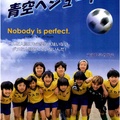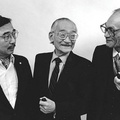The last few years have been tough for newspapers in general and Japanese American newspapers in particular. Newspaper readership overall has been in decline for decades, but in recent years the trend has accelerated, with several weaker mainstream newspapers becoming either yesterday’s news or going strictly digital in operation.
Closer to home, 2009 saw San Francisco’s Hokubei Mainichi and Nichi Bei Times cease daily publication. In 2010, Los Angeles’ Rafu Shimpo publicly confirmed what many had feared, that it, too, was in dire straits.
To my eyes, three of the main causes for the problems facing the Japanese American newspaper are: 1) demographics; 2) the success of the civil rights movement; and 3) past efforts by Japanese Americans to assimilate and acculturate. In some ways, the causes are interlinked.
Demographics show that as a group, Japanese Americans peaked years ago in population and have been surpassed when compared with other Asian American groups. Yes, the influence of Japanese Americans among all Asian Americans at the national level is still worth something, thanks to folks like Sen. Daniel Inouye and current and former Cabinet members like Eric Shinseki and Norman Mineta, respectively. But those examples are likely to be historical footnotes in a few years.
Once the most-populous Asian American group, Japanese Americans have been overtaken by Chinese and Koreans thanks to changes in immigration laws that took place in the mid-1960s that took a few years to manifest.
A case in point: While there have been Chinese Americans for decades, the “ABC’s” are now far outnumbered by the “FOB’s,” a change that can be credited to the civil rights movement that helped lead to said changes in immigration laws.
Meanwhile, nowadays comparatively few Japanese emigrate from their homeland to the U.S. compared with other Asian nations, and for those who do, they don’t necessarily interact with Japanese Americans and Japanese American institutions.
Even when Japanese from Japan become part of the existing Japanese American populace, the numbers are not enough to counter the declining Japanese American population. Japan itself is facing a decline in population within its shores, which is a result of prosperity and Japan’s anti-immigration policies. If not for immigration, the populations of many industrialized and modernized nations, including the United States, would have shrunk, too.
The Japanese American population is mature compared with other Asian American groups. That’s why we have the Japanese American National Museum, the JACCC, and a UCLA building named after Paul Terasaki. Newer immigrant adults from South Korea, for example, trying to put food on the table and get their kids through school have other priorities. But I imagine that in the years to come, the Korean Americans who arrived in the 1970s and 1980s whose children have left the nest will want to take stock of their history and legacy. Actually, it’s already happening, since there is a Korean American Museum.
Back to demographics, a look at the obituaries showing the number of Japanese Americans in their 80s and 90s—Nisei, in a word—who are passing is staggering. This slice of the JA demographic, incidentally, is the most likely to subscribe to and support Japanese American newspapers, which doesn’t bode well for the remaining Japanese American newspapers.
Success in the civil rights arena, meanwhile, means that the ethnic enclaves that arose thanks to racist housing laws that kept different groups of people segregated no longer apply. Still, it’s evident that newer Asian immigrants do cluster in places like the San Gabriel Valley, where many Chinese landed or Orange County’s Little Saigon for Vietnamese. But with education and affluence, more Asian Americans from those areas will likely disperse.
Nowadays anyone can live pretty much wherever they can afford. Not only that, anti-miscegenation laws have fallen by the wayside. But Japanese Americans are marrying not only Whites, Blacks and Latinos, they are marrying those from other Asian backgrounds, be they Chinese, Korean, Vietnamese or Filipino, not to mention Iranian and so on. Meantime, the stigma for Whites marrying outside their group—something often overlooked—has lessened to the point of becoming a nonissue except to those hardcore White supremacist types.
As for those loaded words acculturation and assimilation, the Nisei succeeded there in typical overachieving style, no doubt driven in large part by the experiences of being singled out for discrimination during WWII.
Although a visitor from outer space might not know it from fictional depictions on TV and in movies, younger Japanese Americans are more culturally American than Japanese; while physical features will distinguish even a mixed-race Japanese American, other than some dietary and vestigial cultural affiliations, a Yonsei or Gosei is simply another American. And wasn’t that the goal?
What does the preceding augur for the future of Japanese American newspapers, two of which—The Rafu Shimpo and Pacific Citizen—are based in here in Los Angeles?
Regarding the Pacific Citizen, its constituency is mainly members of the JACL—which is experiencing its own decade’s long slide in membership—across the country. That it’s a JACL paper is a limitation, since not every Japanese American wants to be a JACL member, although the paper’s national focus is a strong point. But the politics of the organization can be a hindrance to the paper’s ability to make changes. I have to note also that its frequency of newsprint publication to twice a month (from weekly when I worked there) doesn’t help it in the Internet age.
As for The Rafu Shimpo, where I am a columnist, last year there was enough concern about its future following the experience of San Francisco’s Nikkei papers to launch a grassroots “Save the Rafu” movement, followed by an L.A. Times article by Teresa Watanabe about the problems it is facing. By November, however, the Save the Rafu Committee threw in the towel. It turned out that concerned community members trying to advise business owners how to run their business was a doomed effort, laudable as it was.
So, if you’ve made it this far and are wondering what I think, here goes: To be blunt, unless major changes occur, it’s just a matter of time before The Rafu Shimpo ceases daily publication.
Is there anything that can be done? I think so. Here are some some concrete, real-world steps that can be taken to turn things around. Some of it is specific to The Rafu Shimpo but some of it could be applied to other Japanese Americans newspapers as well.
But before that, I should ask the obvious, fundamental yes-or-no question: Does the Japanese American community need The Rafu Shimpo or other community news outlets? If you answer no, then there is no point to continue. Pull the plug on the patient now, doctor. If you answer yes—and that is my opinion—then read on.
But before that, clarification is needed on what business a newspaper is in. If you answer “newspapers,” that’s a problem. At present, the idea of disseminating news on a daily basis, with newsprint as the medium, is no longer wise or sustainable. It’s too slow, too expensive and too wasteful.
But if your answer to what business a newspaper is in is “news,” powered by subscriptions and advertising revenue, then there is still hope.
1) Money: Applying the “ABC’s of first aid” model to the situation, the “A” stands for airway. To me, air in this case equates to money. Unless things have changed radically for the better since last year’s “Save the Rafu” community forum when it was revealed that The Rafu Shimpo was $350,000 in debt and facing a tenuous future, finances are still the biggest issue facing the paper’s survival.
An infusion of capital is clearly required. How can the necessary funds be obtained? One way might be to open the doors to this family-run business to new partners in return for an ownership stake. Within the Japanese American community are some wealthy individuals, business people, entrepreneurs, farmers and the like who would prefer (or could be convinced of the need) to see The Rafu Shimpo continue. They may not be in the media or newspaper business, but they know how to make a buck, a valuable skill.
Maybe some discreet (or not so discreet) queries need to be made to some of those wealthy, community-minded types. In exchange for a piece of the business, they could get a seat on a board of advisers and get a say in how to turn things around. They could also expect to eventually earn some money for their investment.
Another possibility: Partnering with an existing online media company. HuffingtonPost.com was in the news just recently because its founder, Arianna Huffington, made a $315 million deal with America Online. Could The Rafu Shimpo do something similar, albeit on a much smaller scale, with, say Yahoo? Maybe. Yahoo co-founder Jerry Yang’s wife is Akiko Yamazaki. Could they be persuaded to have their company use its existing online infrastructure in concert with an ethnic media outlet like the Rafu and utilize its expertise in reaching the Japanese American community as a test case that could, if successful, could be applied to Chinese Americans, Korean Americans, Vietnamese Americans, and so on? It’s worth investigating at the very least.
2) Restructuring: As mentioned, The Rafu Shimpo is a family-run business. Traditionally in this country, that’s what most newspapers originally were. The Los Angeles Times with the Chandlers, the New York Times with the Sulzbergers, the Washington Post with the Grahams. When Rupert Murdoch’s News Corp. bought Dow Jones & Co. and its Wall Street Journal, he had to deal with members of the Bancroft family.
As I understand it, a similar situation exists for The Rafu Shimpo, with about a dozen family members, some of whom have nothing to do with the day-to-day running of the business, having a stake in the company. If this is the case, it means there is an inefficient, unwieldy structure in place that makes it difficult for the paper’s publisher to act quickly and decisively when a consensus must first be reached.
Presuming the preceding is accurate, steps need to be taken to streamline the operation. It could be tied into the scenario in which new business partners are brought in; as new owners come in, existing family members’ stakes are bought out, if not all at once then over time until a leaner, more efficient structure is in place that retains what works and gets rid of what doesn’t.
3) Area of Coverage: The Rafu Shimpo has traditionally been a Southern California newspaper, Los Angeles to a bit more exact. I’ve heard that the word “Rafu” is derived from a slang term Issei used long time ago for Los Angeles. Regardless, the Rafu Shimpo is, among Japanese Americans in Southern California, a trusted, well-known brand with a 100-year plus track record. That may be the best thing going for it.
With a shrinking subscriber base, however, it’s time to rethink that Los Angeles/So Cal emphasis and think nationally (if not globally). The obvious answer on how to do that is to exploit the inherent strengths of the Internet—speed, reach, scalability, multimedia and more. That The Rafu Shimpo has a website—www.Rafu.com—is to be commended, but it needs more resources and a plan of action to capitalize on all the Web has to offer.
Nevertheless, I think The Rafu Shimpo should continue publishing in newsprint until it no longer makes any economic sense to do so. This could mean five, 10 or maybe 15 more years, especially if the Japanese language section can justify such a scenario. It will also keep jobs for some of the aging staffers until they can retire.
Still, though, because most people get their Rafu Shimpo via the USPS—a.k.a. “snail mail”—with the inherent costs of ink, paper, and postage, not to mention lack of speed, the underlying main idea should be transitioning from print to pixels.
*George Toshio Johnston can be reached at George@NikkeiNation.com. Published on DiscoverNikkei.org with permission of the author. All rights reserved.
© 2011 George T. Johnston





